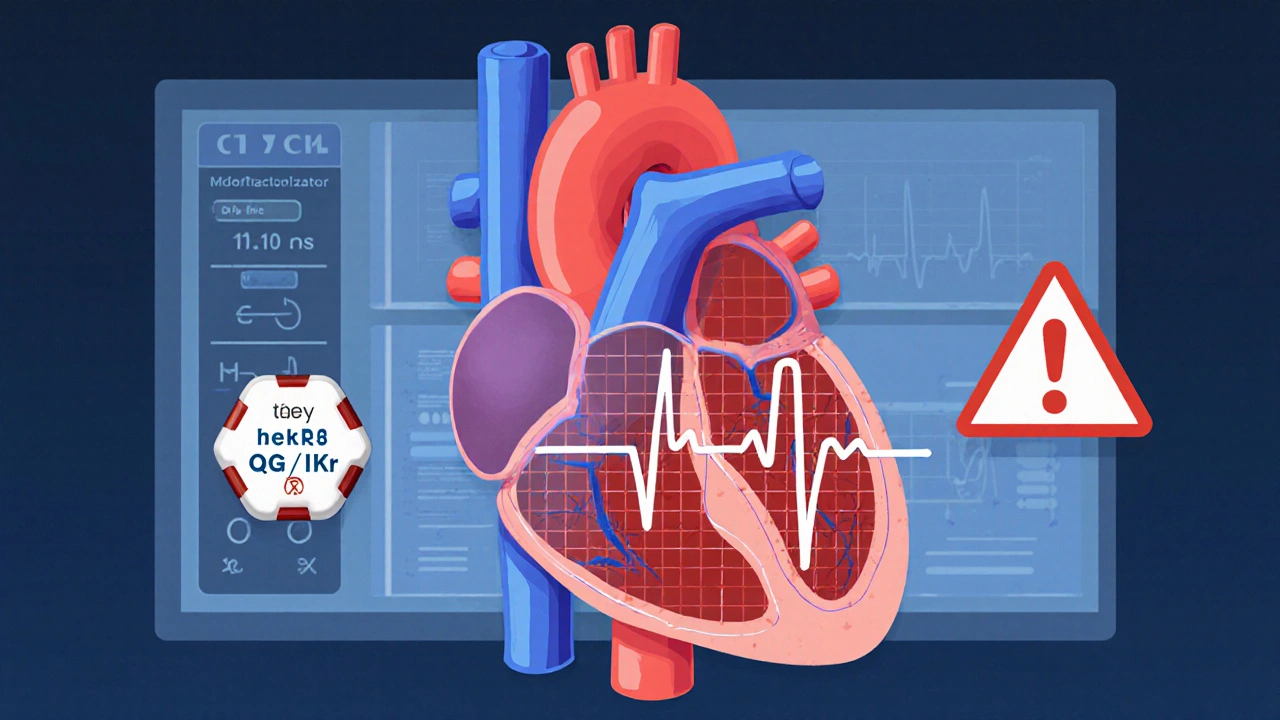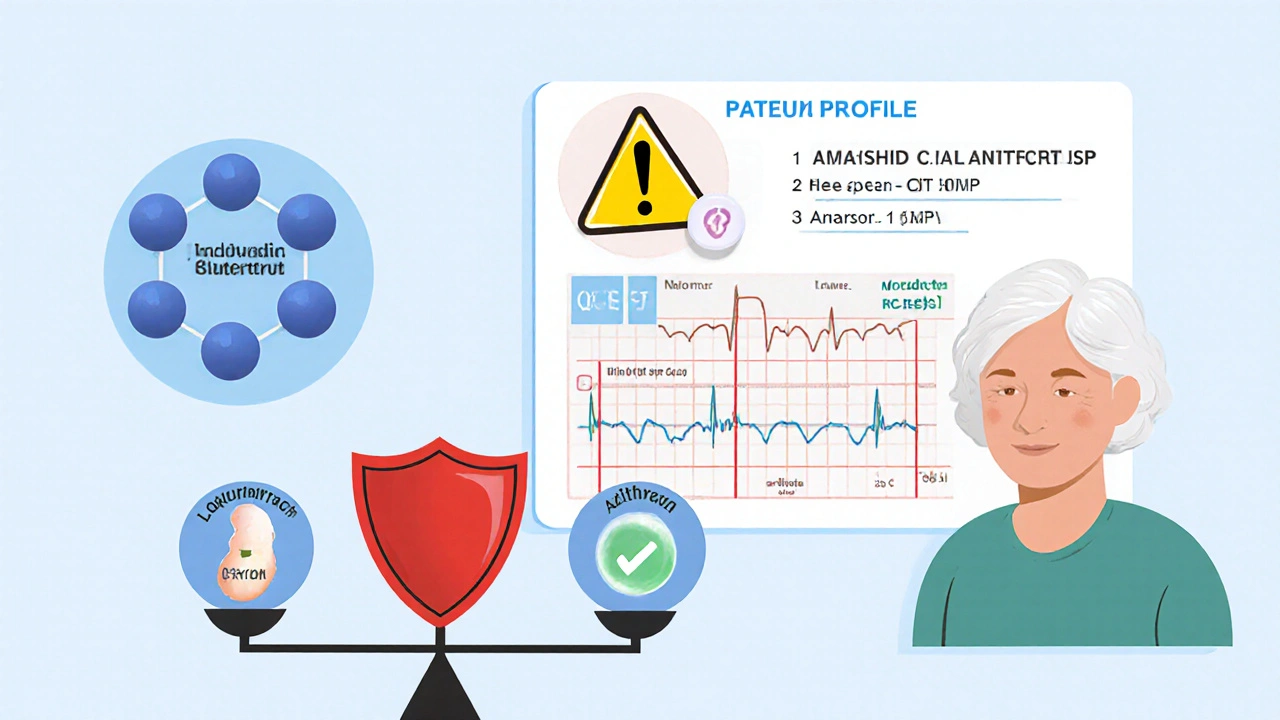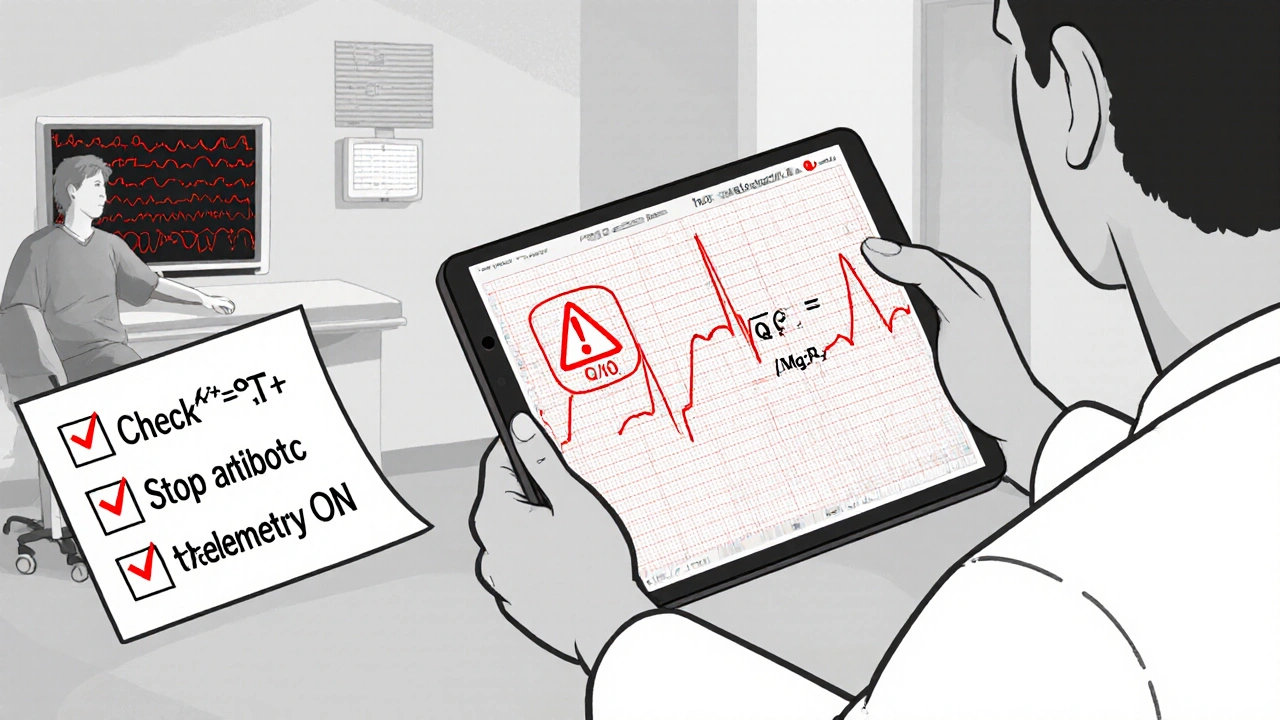QT Prolongation with Fluoroquinolones and Macrolides: Monitoring Strategies
 Oct, 30 2025
Oct, 30 2025
QTc Interval Calculator
Calculate Corrected QT Interval
Input QT interval and heart rate to calculate corrected QTc interval using standard formulas. Essential for assessing antibiotic safety risk.
QTc Result
CriticalQTc interval > 500 ms indicates high risk for Torsades de Pointes. For women, QTc > 470 ms is prolonged. Consider stopping QT-prolonging antibiotics.
Important: Always confirm QT prolongation with proper ECG measurement. Consult clinical guidelines for patient management.
When a doctor prescribes an antibiotic like ciprofloxacin or azithromycin, most people think about fighting infection-not heart rhythm. But for some patients, these common drugs can quietly disrupt the heart’s electrical system, leading to a dangerous condition called QT prolongation. This isn’t theoretical. It’s happened. And it can kill.
What QT Prolongation Really Means
The QT interval on an ECG measures how long it takes the heart’s lower chambers (ventricles) to recharge between beats. When this interval stretches too long, the heart becomes electrically unstable. That’s when Torsades de Pointes-a twisting, chaotic rhythm-can kick in. It’s not just a scary word. It’s a medical emergency. Without quick treatment, it turns into sudden cardiac arrest.
Fluoroquinolones (like ciprofloxacin, levofloxacin, moxifloxacin) and macrolides (like erythromycin, clarithromycin, azithromycin) are two of the most common antibiotic classes linked to this risk. They block a specific potassium channel in heart cells (hERG/IKr), slowing down repolarization. Think of it like a traffic jam in the heart’s electrical signal. The longer the jam, the higher the chance of a crash.
Not All Antibiotics Are Created Equal
Just because two drugs are in the same class doesn’t mean they carry the same risk. The difference matters-especially when you’re treating an older patient with kidney issues or on other heart medications.
Among fluoroquinolones:
- Moxifloxacin has the highest risk-used cautiously, if at all, in high-risk patients.
- Ciprofloxacin and levofloxacin carry low to minimal risk, but still require caution.
- Sparfloxacin was pulled from the market in the 1990s because it caused so much QT prolongation it acted like a heart rhythm drug.
Among macrolides:
- Erythromycin is the biggest offender-especially when given intravenously. It can mimic antiarrhythmic drugs like sotalol.
- Clarithromycin is next in line, with moderate risk.
- Azithromycin has the lowest risk among macrolides, but it’s not zero. Case reports still exist.
Here’s the reality: if you’re treating a 72-year-old woman with a UTI and she’s on a diuretic, has low potassium, and takes a statin, giving her moxifloxacin or erythromycin isn’t just risky-it’s reckless.
Who’s Most at Risk?
QT prolongation doesn’t happen randomly. It’s the result of stacking risk factors. The more you have, the higher the chance of trouble.
- Age over 65-the heart’s natural repolarization slows with age.
- Female gender-women have a 2 to 3 times higher risk of Torsades de Pointes than men.
- Low potassium or magnesium-levels below 3.5 mmol/L for potassium or 1.7 mg/dL for magnesium dramatically increase risk.
- Heart disease-left ventricular hypertrophy, heart failure (ejection fraction under 40%), or prior heart attack.
- Other QT-prolonging drugs-antidepressants, antifungals, antiarrhythmics, even some antacids.
- Drug interactions-macrolides and fluoroquinolones are often metabolized by the same liver enzymes. If another drug blocks that pathway (like fluconazole or cimetidine), antibiotic levels spike, increasing QT risk.
- Chronic kidney disease-reduces drug clearance, leading to buildup.
- Genetic predisposition-some people carry silent mutations in cardiac ion channels that only show up when a drug is added.
Critically ill patients in the ICU are especially vulnerable. They often have multiple risk factors at once: low electrolytes, kidney failure, sepsis, multiple IV drugs, and mechanical ventilation. One 2021 study tracked ICU patients on IV ciprofloxacin and erythromycin with continuous ECG monitoring. The QT interval spiked within hours of the first dose-sometimes beyond 500 ms.

How to Measure QT Correctly
Not all ECGs are created equal. Measuring QT isn’t just reading a number off a screen. You need to know how it was calculated.
Two formulas are used to correct QT for heart rate:
- Bazett’s formula (QTc = QT / √RR)-still used in many hospitals, but it overcorrects at fast heart rates and undercorrects at slow ones.
- Fridericia’s formula (QTc = QT / ∛RR)-more accurate, especially for predicting mortality. It’s now the preferred method in guidelines from 2023 onward.
And here’s a trap many miss: if the patient has a bundle branch block, pacemaker, or wide QRS complex (>140 ms), the QT measurement is unreliable. The ECG machine might show a long QT, but it’s not the heart’s repolarization-it’s the conduction delay. You need to look at the T-wave morphology, not just the number.
Also, QTc thresholds matter:
- Men: >450 ms = prolonged
- Women: >470 ms = prolonged
- Any QTc >500 ms = high risk for Torsades-act immediately.
When and How to Monitor
Monitoring isn’t optional for high-risk patients. It’s standard care.
For macrolides:
- Do a baseline ECG before starting-especially if the patient is over 65, female, or on other QT-prolonging drugs.
- Repeat the ECG one month after starting therapy. This is mandated by British Thoracic Society guidelines.
- If QTc increases by more than 60 ms from baseline, stop the drug.
For fluoroquinolones:
- Check ECG 7 to 15 days after starting treatment.
- Repeat monthly for the first three months.
- After that, monitor periodically if risk factors persist.
Timing matters. Studies show QT prolongation peaks 2 to 4 hours after IV dosing. So if you’re doing a check, do it then-not first thing in the morning.
For patients with multiple risk factors-like a woman on furosemide, with CKD, on amiodarone, and now prescribed azithromycin for pneumonia-consider telemetry monitoring during hospitalization. Don’t wait for a rhythm to go bad.

What to Do If QT Prolongation Happens
Don’t wait. If QTc exceeds 500 ms or increases by more than 60 ms from baseline, stop the antibiotic immediately.
Next steps:
- Check electrolytes. Correct potassium to above 4.0 mmol/L and magnesium to above 2.0 mg/dL. IV magnesium sulfate is the first-line treatment for Torsades.
- Discontinue all other QT-prolonging drugs, even if they’re not antibiotics.
- Consider temporary pacing if bradycardia is contributing.
- Never give Class Ia or III antiarrhythmics-they make it worse.
And don’t assume the problem is gone after stopping the drug. QT can stay prolonged for days. Follow up with another ECG in 24 to 48 hours.
Prescribing Better, Not Just More
The real solution isn’t better monitoring-it’s smarter prescribing.
For uncomplicated UTIs in older women? Fluoroquinolones are no longer first-line. Nitrofurantoin or fosfomycin are safer. For respiratory infections? Azithromycin is fine for most-but if the patient is on a diuretic and has heart failure, consider doxycycline or a cephalosporin instead.
Antimicrobial stewardship programs now include QT risk as a key criterion. Hospitals are starting to flag high-risk prescriptions before they’re filled. That’s progress.
The FDA has issued multiple warnings. Drug labels now list QT prolongation as a boxed warning. But the real test isn’t the label-it’s what happens in the clinic, in the nursing home, in the ER.
A 2025 study of long-term care facilities found that nearly 1 in 5 older women with a simple UTI were prescribed a fluoroquinolone-and nearly half of them were on another QT-prolonging drug. That’s not a mistake. It’s a system failure.
Final Takeaway
Fluoroquinolones and macrolides save lives. But they can also end them-if we ignore the heart.
Here’s your checklist:
- Know the patient’s risk profile before prescribing.
- Use Fridericia’s formula to calculate QTc-not Bazett’s.
- Check ECG before and after starting high-risk antibiotics.
- Correct potassium and magnesium before and during treatment.
- Stop the drug if QTc >500 ms or increases >60 ms.
- Choose safer alternatives when possible.
Antibiotics aren’t harmless. The heart remembers what the lungs forget. Monitor wisely-or someone might pay the price.
Can azithromycin cause QT prolongation?
Yes, azithromycin can prolong the QT interval, but its risk is lower than other macrolides like erythromycin or clarithromycin. While rare, cases of Torsades de Pointes have been reported, especially in patients with multiple risk factors like low potassium, heart disease, or older age. It’s not the most dangerous macrolide, but it’s not risk-free either.
Is ciprofloxacin safer than moxifloxacin for QT prolongation?
Yes. Ciprofloxacin carries a low risk of QT prolongation, while moxifloxacin has a moderate to high risk. Moxifloxacin is more likely to cause significant QTc prolongation, especially in patients with existing risk factors. For most patients without cardiac issues, ciprofloxacin is a safer choice when a fluoroquinolone is necessary.
Should all patients get an ECG before taking fluoroquinolones?
No. Routine ECGs aren’t needed for healthy, low-risk patients without heart disease, electrolyte imbalances, or other QT-prolonging medications. But for patients over 65, women, those with kidney disease, heart failure, or on diuretics, a baseline ECG is strongly recommended before starting any fluoroquinolone.
How often should QT interval be monitored during antibiotic treatment?
For macrolides, check ECG before starting and again one month later. For fluoroquinolones, check at 7-15 days after starting, then monthly for the first three months. After that, monitor periodically if risk factors remain. High-risk patients may need continuous telemetry during hospitalization.
Can low potassium make QT prolongation worse?
Absolutely. Low potassium (below 3.5 mmol/L) is one of the strongest risk factors for drug-induced Torsades de Pointes. It makes the heart more electrically unstable. Correcting potassium to above 4.0 mmol/L and magnesium to above 2.0 mg/dL is a critical part of managing QT prolongation-even more important than stopping the antibiotic in some cases.
What’s the difference between Bazett’s and Fridericia’s formula for QTc?
Bazett’s formula (QTc = QT / √RR) tends to overcorrect at fast heart rates and undercorrect at slow ones. Fridericia’s formula (QTc = QT / ∛RR) is more accurate across heart rate ranges and better predicts long-term mortality risk. Guidelines now recommend using Fridericia’s formula for clinical decision-making.
Can QT prolongation from antibiotics be reversed?
Yes, in most cases. Stopping the offending antibiotic and correcting electrolytes (especially potassium and magnesium) leads to QT interval normalization within days. However, if Torsades de Pointes occurs, immediate treatment with IV magnesium and possibly pacing is required. Delayed recognition can be fatal.
Megan Raines
October 31, 2025 AT 23:23So let me get this straight - we’re giving antibiotics like they’re candy, but the heart’s got a VIP list of who gets to survive? 🤦♀️
I got my grandma on azithromycin last year for a ‘mild chest thing’ - turns out she was on furosemide, had low K+, and her ECG looked like a seizure graph. Doc just said ‘it’s fine.’
Turns out ‘fine’ is just the medical term for ‘waiting for the next cardiac event.’
Why do we still treat elderly women like they’re just walking infection bags? We don’t prescribe NSAIDs without checking kidneys - why not check QT before dumping in macrolides?
And don’t get me started on how ECG machines auto-calculate QTc with Bazett’s like it’s 2008. My hospital still uses it. I have to manually recalculate every time. It’s like using a rotary phone in 2024.
Also, why is magnesium IV still the first-line fix? Why not just give people a banana and call it a day? Oh right - because medicine loves IVs more than actual prevention.
Anyway, I’m just glad I’m not the one prescribing this stuff. I’d lose sleep.
Mamadou Seck
November 2, 2025 AT 13:53bro azithromycin is fine unless u got a heart like a wet paper bag
moxifloxacin tho? that shit is a heart grenade
my uncle took it for a sinus infection and ended up in the ICU with some weird twitchy rhythm
doc said he was lucky
lucky??
he was lucky he had a pulse
why the hell are we still using these drugs like theyre just for acne
Anthony Griek
November 3, 2025 AT 12:55I appreciate the depth of this post. Really thoughtful breakdown.
As someone who works in a rural clinic where ECGs are a luxury and potassium levels are often just guessed at, I see this every week.
We don’t have telemetry. We don’t have cardiology on call. We just have a 78-year-old woman with a UTI, a diuretic, and a script for cipro.
It’s not malpractice - it’s system failure.
And honestly? We’re all just trying not to kill someone before lunch.
Maybe the real answer isn’t more monitoring - it’s fewer prescriptions.
Thanks for naming the real problem.
Norman Rexford
November 4, 2025 AT 15:51okay but like why are we even talking about this like its a big deal
americans are so scared of everything
back in my day we just took the pill and prayed
now everyone needs an ekg and a magnesium drip like its a spa day
also fridericia’s formula?? who even uses that
my cousin’s nurse practitioner said bazett’s is fine
and she’s got a degree
also azithromycin is fine for young people
stop being so paranoid
unless you’re old and on 12 meds then maybe dont take it
but dont make everyone else feel guilty for living
Wayne Keller
November 5, 2025 AT 08:03This is one of the clearest, most practical summaries I’ve read on QT risk.
Key takeaway: Don’t just prescribe the antibiotic. Ask: Who is this patient? What are they on? What’s their electrolyte status?
Simple questions. Huge impact.
And yes - Fridericia’s formula. Use it. Even if your EMR doesn’t auto-calculate it, do it manually once. It changes everything.
Also - potassium and magnesium aren’t just ‘nice to have.’ They’re your first-line defense.
If you’re giving azithromycin to someone on a diuretic? Check K+ before you hit ‘send’ on the script.
It takes 30 seconds. Could save a life.
Thanks for the checklist. I’m printing this.
Shana Labed
November 5, 2025 AT 09:03OMG YES THIS IS SO IMPORTANT 🙌
I work in ER and we had a 73yo woman come in with Torsades after a 3-day azithromycin course for bronchitis - she was on hydrochlorothiazide, had CKD, and her K+ was 3.1
She coded. We shocked her. She lived.
But her daughter cried for 20 minutes asking why no one warned them
WE DIDN’T EVEN KNOW
Why isn’t this in every primary care flowchart??
Why isn’t the EHR auto-flagging azithromycin + furosemide + age >65??
It’s not just about knowledge - it’s about systems
Let’s fix the system, not just the docs
Also - magnesium IV is MAGIC 💪
California Daughter
November 6, 2025 AT 16:21Wait… so… you’re saying… antibiotics… can… affect… the… heart…???
But… I thought… they were… just… for… infections…?
And… you mean… we… don’t… just… give… them… to… everyone…?
And… you’re… telling… me… we… should… check… electrolytes…?
And… ECGs…?
And… not… use… moxifloxacin… like… it’s… a… vitamin…?
…
…
…
Wow.
I… feel… so… behind.
Also… why… is… everyone… so… scared… of… azithromycin…?
It’s… just… a… pill…
Right…?
Vishwajeet Gade
November 8, 2025 AT 04:38india dont have this problem
we use cipro all day
no ekg no nothing
people take 500mg 3x a day for 10 days
no one dies
you americans overthink everything
why you need magnesium drip
just drink banana milkshake
and stop being weak
our doctors dont care about QT
they care about saving lives
not paperwork
Casey Crowell
November 8, 2025 AT 19:46🔥 This is the kind of post that makes me believe medicine still has some good people left.
So many docs treat antibiotics like they’re soda - pop one open, no big deal.
But the heart? It doesn’t forget.
I’ve seen patients recover from Torsades… but their families never recover from the guilt.
And yeah - Fridericia’s formula. Use it. Even if your EMR doesn’t auto-calculate it, do it manually once. It changes everything.
Also - potassium and magnesium aren’t just ‘nice to have.’ They’re your first-line defense.
If you’re giving azithromycin to someone on a diuretic? Check K+ before you hit ‘send’ on the script.
It takes 30 seconds. Could save a life.
Thanks for the checklist. I’m printing this.
❤️🫂